Spray Drying System
As the word suggests in a single stage spray dryer the final product has its moisture content when it comes out of the dryer. This type of systems are generally used in industries where particle size lies between 20 micron to 250 micron.
In this system hot air enters through the nozzle at high velocity and product to be dried passes through the atomizer to make the optimal mixer with high velocity hot air. The evaporation of moisture takes place in the drying chamber and the resultant dried product is obtained at the bottom of the chamber. The powder is collected and transferred through a pneumatic conveying system or if further drying required then passes through the cyclone which separates the fine particles and sends it to a bag filter or scrubbing system where air is filtered to meet the emission norms.
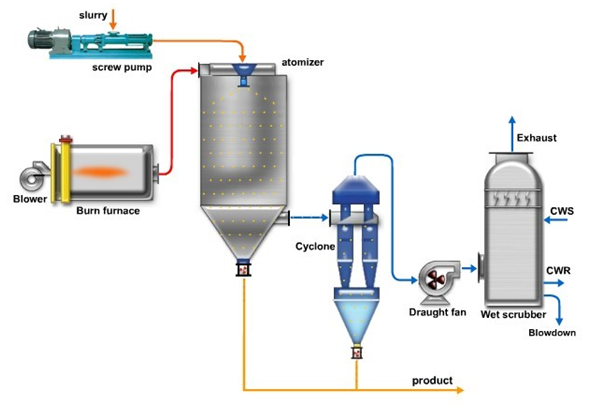
Fig.-1 : Spray Drying System
Vibrational fluid bed dryer
Vibrational fluid dryer is usually used for powder which is already dried from a spray dryer and requires further drying. This system is also used individually for removing dust from products.
The powder is vibrated on a bed having perforated plates through which hot air is supplied. Perforated holes in the plates are designed based on the type of product which is to be dried. First a hot stream of air is supplied and then a cold stream of air is supplied which cools the powder and results in the final cool,dried powder.
Benefits
- Suitable for temperature sensitive materials
- Can handle powder layer of up to 180mm thickness
- prevents material from burning or discoloration
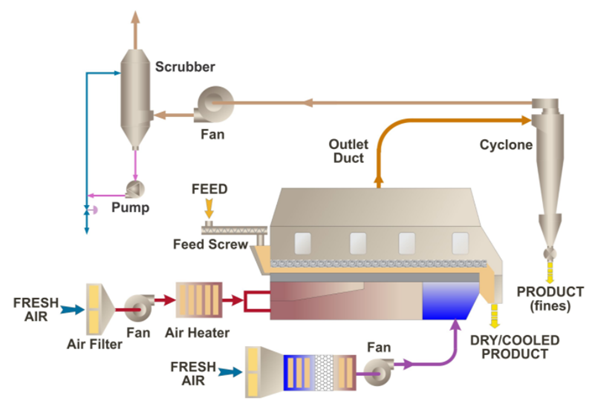
Fig.-2 : Vibrational Fluid Bed Dryer
Flash Dryer
Flash dryers are the most versatile among all categories of dryers. It can be used where there are frequent changes in product type.
Cake or product to be dried is passed through the stream of hot air and the dried product is separated in a cyclone. Further exhaust air is passed through a bag filter to meet the emission requirements.
Benefits
- Simple system with few moving parts so maintenance and cleaning is easy
- shorter residence time can be achieved
- less moving parts resulting in high energy savings
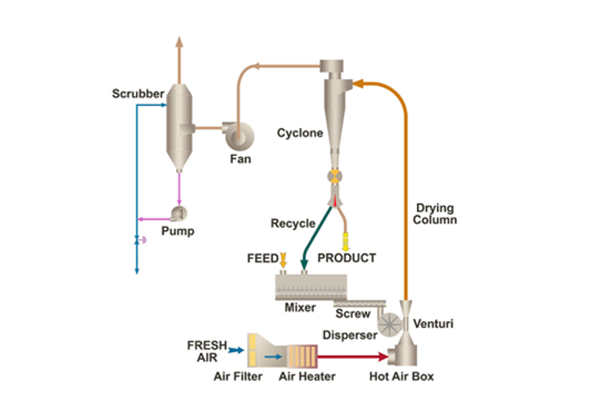
Fig.-3 : Flash-Dryer
Spin Flash Dryer
Spin flash dryer is a vertical dryer with rotary pulverizing device, which can simultaneously dry, pulverize and classify materials. It is a continuous drying device specially designed for drying filter cake, paste and muddy materials.
The clean air heated by the heat source enters the drying chamber in a tangential form, forming a powerful vortex swirling airflow with the mechanical agitation mechanism. The wet material is metered into the drying chamber by a feeder, pulverized and dried by stirring and vortex flow. The top of the drying chamber is set with a particle size classifier. The fine powder that meets the drying requirements is discharged from the top of the tower and collected by the latter separator. The larger particles that do not meet the drying requirements are blocked by the classification ring, returned to the drying chamber, and continue to be pulverized and dried. After drying to qualified product, it is discharged out of the drying chamber with hot air and collected by a separator.
Benefits
- The double vortex flow feed system ensures proper mixing of hot medium and wet medium.
- Reduced drying time
- Ideal for less viscous and low solid content materials
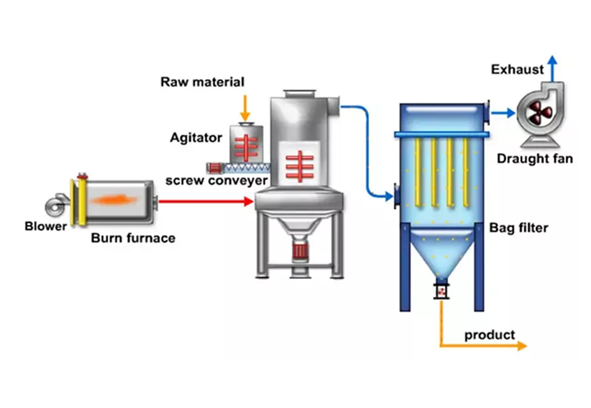
Fig.-4 : Spin Flash Dryer
Rotary Dryer
In a Rotary dryer the product is passed through a hot gas stream to remove the moisture content. The product is fed from the top of a horizontal rotating vessel and a hot air stream is continuously fed from one end. The product moves towards the other end by exchanging heat with hot air and finally comes out at the other end. The exhaust air is further refined using a cyclone and finally through a bag filter and released into the atmosphere meeting environmental norms.
Benefits
- Suitable for wide range of particles and material
- Higher drying temperatures could be achieved
- long residency time
- smaller equipment size
- reduced energy requirements
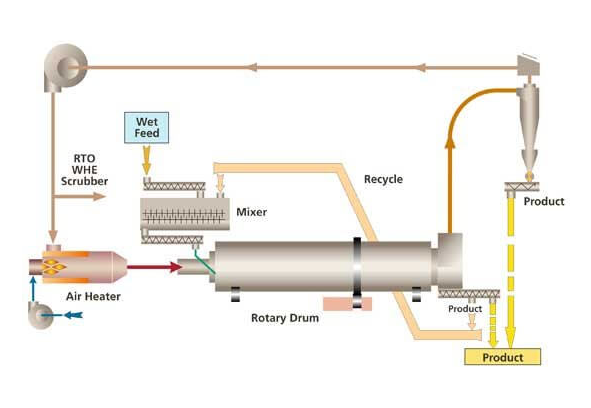
Fig.-5 : Rotary Dryer
Air dryer
Desiccant dryer works on the principle of adsorption. Compressed air which is to be dried flows through one tower containing adsorption material while the other tower is regenerating. The moisture is adsorbed by collecting it in the pores or molecular sieves. Regeneration is achieved by reducing the pressure in the tower and passing purge air though the desiccant medium.
Benefits
- Skid mounted modular design
- long life compared to refrigerated air dryers
- low maintenance
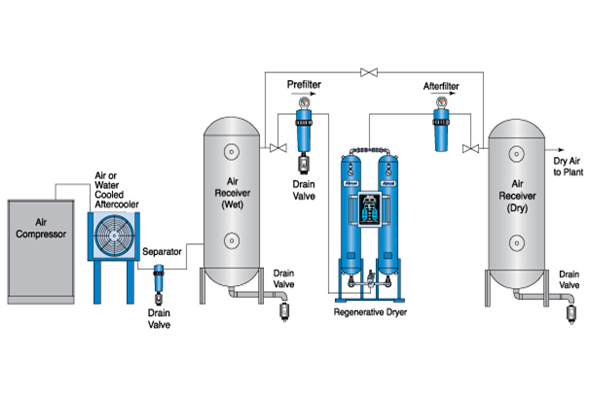
Fig.-6 : Air Dryer
Pneumatic Conveying Systems
The pneumatic conveyor system uses differential air pressure to efficiently move materials from one point to the other. Since air flows from high to low pressure, its application at one end of the pipe will move bulk materials to the other end.
Pneumatic systems are classified as negative pressure systems which use a vacuum to pull materials or positive pressure devices that use compressors to push bulk materials. On application of pressure or vacuum, the solid particles become airborne and are thus transported.
Pressure Conveying Systems
The powder will be gravity feed from hopper or drumper, to blow through valve and conveyed to cyclone cum bag filter – storage silo through fixed piping. The powder collected at storage silo will be gradually and continuously discharge to Bags by drop through rotary valve. dilute Phase pressure conveying system, using air as conveying media and roots blower as pressure generator pump / prime mover. The conveying air with powder separated at storage silo due to velocity & area difference and the fine material retains by Bag filter and clean dust free air exhausted to atmosphere.
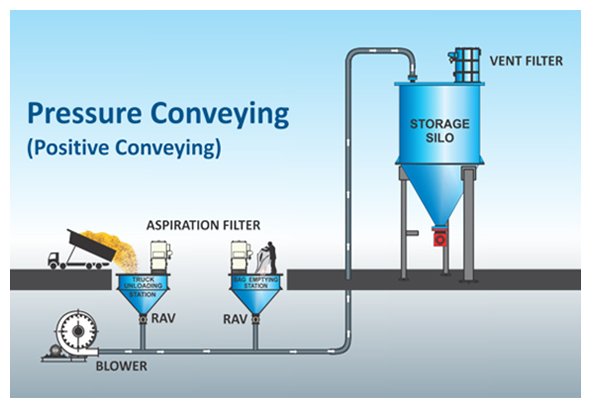
Fig.-7 : Pressure Conveying Systems
Lean Phase Vacuum Conveying Systems
The product will be collected at Feed hopper, will be sucked through aeration nozzle & flexible hose. On initiation of conveying, through control panel, the vacuum pump operates & air from vacuum generator suck through the conveying piping & convey product from hopper to the Bag filter using air as media. The collected product at filter cum separator will be discharge to further process line / packing plant through bottom butter fly valve. In order to limit the dust concentration in the vented air, the filtering unit will be supplied with auto dust cleaning arrangement by compressed air with timer, solenoid valves and controls.
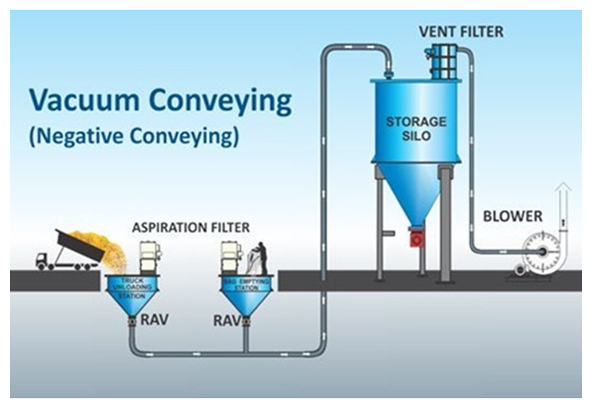
Fig.-8 : Lean Phase Vacuum Conveying Systems
Dense Phase Conveying Systems
Dense phase conveying Systems are designed to maximize the space and utility with efficient silo discharge devices and dust control. Weighing and Batching include precision load cell based systems integrated with automatic valves and PLC. The combination gives precise weighing, metering and dosing of products to the downstream processes for consistent batch quality. Many Powder Handling systems require weighing of large amounts of material and the preparation of product batches for ingredient formulations. Typical applications are for food mixes, breakfast cereals, pharmaceuticals and many others. Custom-engineered systems increase output and product consistency, eliminates waste and generate production data. They can also upgrade the levels of automation, data capture and automatic feedback based process of the systems. High accuracy load - cells and weigh controls electronics. Major, Minor and Micro ingredient dosing systems. Safe, Sanitary and dust free system. The Control and recipe management done by using SCADA/HMI Software for process visualization, inventory control & reporting functions for management information system.
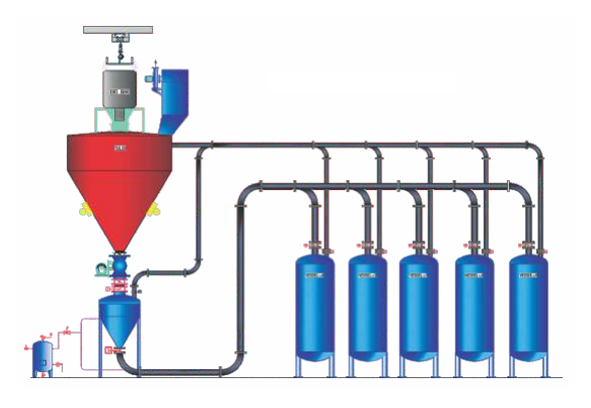
Fig.-9 : Dense Phase Conveying Systems
Rotary Valve
Rotary valve are used as an airlock feeder valve at the bottom of pressurized vessels (both negative & positive) such as dust collectors, cyclones & hoppers. Rotary valves are used for wood dust & shavings, paper, animal feed and cereals, plastics and many other free following products.
They are fabricated in 3mm black plate and painted and have a rotational speed of 20 rpm. Rotary valves have 6 blades with rubber tips and have a bearing at one end and a gear box & motor mounted directly on the other end.
The approximate capacity of a rotary valve is calculated at 50% full when used under dust collectors, cyclones etc. When used as a rotary feeder under hoppers, the rate can be increased to 80-90% of total capacity.
Fig.-10 : Rotary Valve
